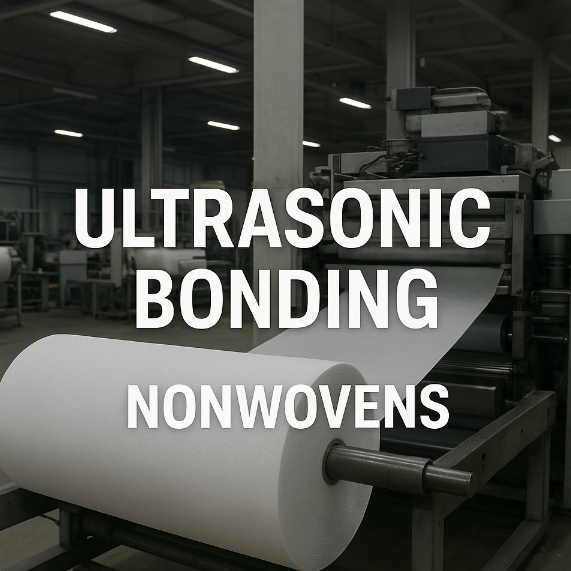When you search for “ultrasonic bond” or “ultrasonic bonding nonwovens,” you’re looking for a cleaner, stronger, and more advanced way to fabricate materials. You’ve come to the right place. This comprehensive guide will demystify the ultrasonic bonding process, explain why it’s revolutionizing the nonwoven industry, and explore its groundbreaking applications.
📑 Article Navigation
🔬 What is Ultrasonic Bonding? A Simple Explanation
In simple terms, Ultrasonic Bonding (also known as ultrasonic welding) is a versatile, solvent-free technique used to join synthetic materials together. It uses high-frequency sound waves to create friction and heat within the materials themselves, causing them to melt and fuse at the molecular level under pressure.

Think of it as “sewing with sound.” There are no threads, glues, or chemicals involved. This makes it an exceptionally clean, efficient, and environmentally friendly bonding method, particularly crucial for producing high-quality nonwoven fabrics.
⚙️ How Does the Ultrasonic Bonding Process Work? (Step-by-Step)
The “ultrasonic bonding process” might sound complex, but it can be broken down into four straightforward stages—all happening in a fraction of a second.
The Stack
Layers of nonwoven fabric are placed between the ultrasonic horn and patterned anvil, ready for bonding.
Pressure & Vibration
The horn applies pressure and vibrates at ultrasonic frequency (20,000-40,000 times per second).
Internal Friction & Melting
Vibration creates friction, generating localized heat that melts synthetic fibers at bond points.
The Bond Formation
Molten polymer flows together and solidifies under pressure, creating a permanent molecular weld.
💡 Why Choose Ultrasonic Bonding for Nonwovens? The Key Benefits
Ultrasonic bonding has become the preferred method for manufacturers worldwide. Here’s why:
No Consumables
Eliminates the cost and complexity of adhesives, threads, or other bonding agents, reducing production costs and simplifying supply chains.
Clean & Porous
Produces completely residue-free bonds ideal for sensitive applications. Unbonded areas maintain original softness and breathability.
Energy Efficient
Heat generation is precisely localized at bond points, achieving 60-80% lower energy consumption compared to thermal bonding methods.
Superior Strength
Creates molecular-level welds that resist fraying and unraveling, often exceeding the strength of the base material itself.
High-Speed Production
Extremely fast process (0.1-0.5 seconds per bond) with easy automation for maximum throughput in high-volume manufacturing.
Eco-Friendly
Chemical and solvent-free process reduces environmental impact and supports sustainable manufacturing initiatives.
🏭 Top Applications of Ultrasonic Bonded Nonwoven Products
You encounter ultrasonic bonded nonwovens more often than you might think. Explore the diverse applications across industries:
Medical & Hygiene
Surgical gowns, face masks, medical drapes, wound care products, and diapers requiring absolute sterility and lint-free performance.
Filtration Systems
Air filters, HVAC systems, and liquid filter cartridges where strong, rigid structures are essential without glue-induced clogging.
Automotive Interiors
Trunk liners, headliners, door panels, and insulation components designed to withstand harsh automotive environments.
Geotextiles
Erosion control mats and land stabilization fabrics requiring exceptional durability and long-term structural integrity.
Packaging Solutions
Sterile medical packaging and resealable wipes packaging with reliable hermetic seals and tamper-evident features.
Apparel & Fashion
Labels, appliqués, and decorative seams in reusable bags and fashion items for clean finishes and fray prevention.
🔮 Conclusion: The Future of Bonding is Sonic
Ultrasonic bonding represents more than just a manufacturing process—it’s a smarter, cleaner, and more efficient paradigm for creating high-performance nonwoven products. By understanding the “ultrasonic bonding process” and its multifaceted benefits, it becomes clear why this technology dominates demanding industries from healthcare to automotive engineering.
If you’re developing products that require strong, clean, and reliable bonds without the limitations of traditional methods, ultrasonic bonding offers the innovative solution you need for tomorrow’s challenges.
❓ Frequently Asked Questions
Ultrasonic bonding is primarily effective on thermoplastic synthetic fibers (polypropylene, polyester, nylon). Natural fibers without synthetic content lack the melting properties needed for effective ultrasonic bonding. For blended materials, the synthetic component enables bonding while natural fibers provide other desirable properties.
While initial equipment investment is significant, the elimination of ongoing consumables (adhesives, threads) combined with high production speeds and reduced energy consumption typically delivers an excellent ROI in high-volume manufacturing. Many operations achieve full payback within 12-18 months.
Unlike thermal bonding that applies external heat across the entire fabric (potentially causing stiffness and reduced breathability), ultrasonic bonding localizes heat at specific bond points, preserving the fabric’s original softness, flexibility, and breathability in unbonded areas while creating stronger, more precise bonds.
Thermoplastic nonwovens containing polypropylene, polyester, or polyethylene work exceptionally well. The process is most effective with synthetic content of at least 20-30% to ensure proper bonding. Material thickness, fiber denier, and polymer characteristics all influence bond quality and process parameters.
